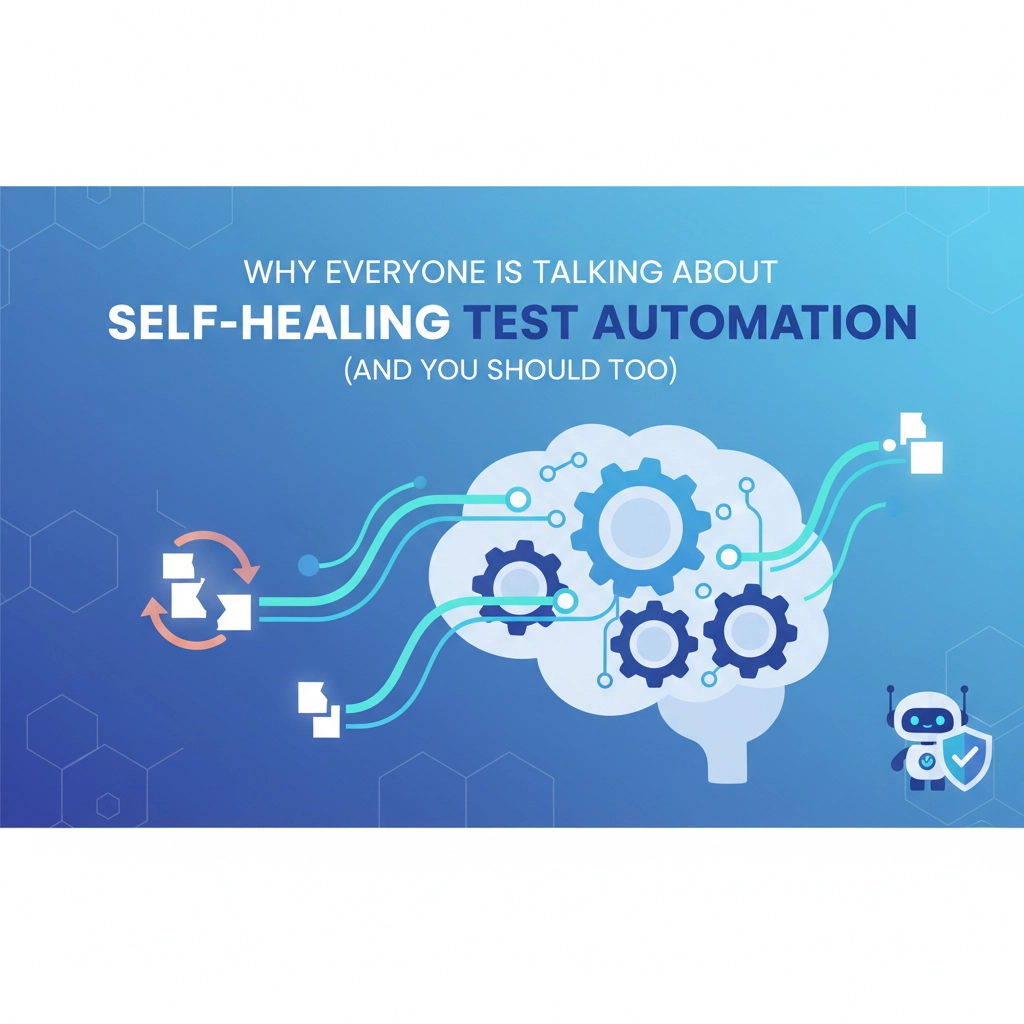Walk into any QA conference today, and you'll hear the same conversations buzzing everywhere: self-healing test automation. It's not just another tech trend: it's solving one of the biggest headaches in software testing. And if you're still wrestling with broken test scripts every time your developers push an update, you're about to discover why this technology is changing everything.
The Problem That's Been Driving QA Teams Crazy
Here's the scenario every QA professional knows by heart: Your automated tests run perfectly on Monday. Tuesday morning, the development team pushes a small UI update. By Tuesday afternoon, half your test suite is broken, throwing errors left and right.
Sound familiar? You're not alone.
Traditional test automation relies on fixed element identifiers: specific buttons, fields, and components that must stay exactly where the developers originally placed them. When anything changes (and it always does), your tests break. What should be your safety net becomes a maintenance nightmare.
The result? Teams spend more time fixing tests than actually testing. Some organizations report that up to 70% of their QA effort goes toward maintaining existing automation instead of building new coverage. That's not testing: that's digital housekeeping.

What Self-Healing Test Automation Actually Does
Self-healing test automation flips this dynamic completely. Instead of rigid scripts that break at the first sign of change, these systems actively adapt to application updates in real-time.
When a test encounters a changed element, self-healing technology doesn't just fail and wait for manual intervention. It intelligently searches for the element using alternative identification methods, learns from the change, and updates itself automatically. The test continues running, your coverage stays intact, and you get reliable results without lifting a finger.
Think of it as having an expert QA engineer watching every test execution, instantly fixing issues as they appear, and documenting the changes for future reference. Except this engineer never sleeps, never takes vacation, and works at machine speed.
Maintenance Time Drops to Nearly Zero
The most immediate impact teams notice is the dramatic reduction in test maintenance overhead. Organizations using self-healing automation report cutting their maintenance time by 60-80%. That's not just efficiency: it's transformation.
Your QA team stops being reactive firefighters and becomes proactive quality architects. Instead of spending Thursday fixing Monday's broken tests, they're designing comprehensive test coverage for next week's features. The time savings compound quickly, freeing up bandwidth for strategic testing initiatives that actually move the needle on quality.
Test Coverage Expands Dramatically
With maintenance burdens lifted, teams naturally expand their automated test coverage. What once required careful prioritization because of limited maintenance capacity now becomes feasible across entire applications.
The math is compelling: if maintaining 100 automated tests previously consumed 40% of your team's time, self-healing automation reduces that to under 10%. Suddenly, you can realistically maintain 300-400 tests with the same resource allocation. More coverage means earlier defect detection, reduced production issues, and higher confidence in every release.

Faster Feedback Loops Accelerate Everything
Self-healing automation creates faster, more reliable feedback cycles with development teams. When tests adapt automatically instead of breaking, developers get consistent quality signals throughout their work. No more waiting for QA to fix broken automation before getting meaningful test results.
This accelerated feedback translates directly to faster iteration cycles. Features move from development to production with fewer roadblocks, less back-and-forth, and higher confidence. Development velocity increases while quality metrics improve: the best of both worlds.
False Positives Become History
Nothing kills confidence in automated testing faster than false positives. When tests fail because of cosmetic UI changes rather than actual defects, development teams start ignoring automation results entirely.
Self-healing systems eliminate most false positives by distinguishing between meaningful failures and superficial changes. Tests adapt to minor UI updates while still catching genuine functional issues. This builds trust in automated testing across the entire organization, making test results actionable rather than noise.
The AI Advantage Gets Smarter Over Time
Modern self-healing automation leverages machine learning to continuously improve its healing capabilities. These systems don't just fix problems: they learn from each interaction, building more sophisticated understanding of application patterns and user behaviors.
Over time, the system becomes more accurate at predicting which changes are cosmetic versus functional, more efficient at finding alternative element identifiers, and more reliable at maintaining test integrity. It's automation that gets better the more you use it.

How TMS ONE Delivers Self-Healing Power
TMS ONE integrates self-healing capabilities directly into our unified testing platform, making this advanced technology accessible without complex setup or specialized expertise. Our system monitors every test execution, automatically identifying and resolving issues before they impact your testing workflow.
When elements change in your application, TMS ONE's self-healing engine uses multiple identification strategies to locate moved or modified components. The system updates test scripts automatically while maintaining detailed logs of all changes for audit and review purposes.
The result is seamless automation that adapts to your application's evolution without breaking your testing pipeline. Teams report implementing comprehensive automation coverage 3x faster with TMS ONE's self-healing capabilities compared to traditional approaches.
Cost Efficiency That Compounds
While self-healing automation requires initial investment, the economics are straightforward. Organizations typically achieve ROI within the first quarter through reduced maintenance overhead alone.
Consider the math: if your QA team spends 15 hours weekly maintaining automated tests, that's roughly 780 hours annually. Self-healing automation reduces this to under 200 hours, saving 580+ hours of skilled professional time. Even conservative hourly valuations show significant cost savings that grow with scale.
These savings compound as test coverage expands. Teams can achieve enterprise-level automation coverage with startup-level maintenance overhead, fundamentally changing the cost equation for comprehensive quality assurance.

Why You Should Act Now
Self-healing test automation isn't experimental technology: it's proven capability delivering measurable results across organizations of all sizes. Early adopters report competitive advantages through faster releases, higher quality, and more strategic QA focus.
The question isn't whether self-healing automation will become standard practice: it's whether you'll be among the leaders who adopt it early or the followers who scramble to catch up later.
Every day spent maintaining broken tests is a day not spent building better coverage, exploring edge cases, or designing strategic quality initiatives. Self-healing automation doesn't just solve today's maintenance problems: it unlocks tomorrow's testing possibilities.
The conversations happening at QA conferences aren't just about cool new technology. They're about fundamental shifts in how quality assurance operates, scales, and delivers value. Teams using self-healing automation work differently, think differently, and achieve different results.
Your testing strategy either evolves with these advances or gets left behind by them. The choice is yours, but the clock is ticking.
Ready to experience self-healing automation firsthand? Explore TMS ONE's capabilities and discover how intelligent automation transforms your quality assurance from reactive maintenance to proactive innovation.
